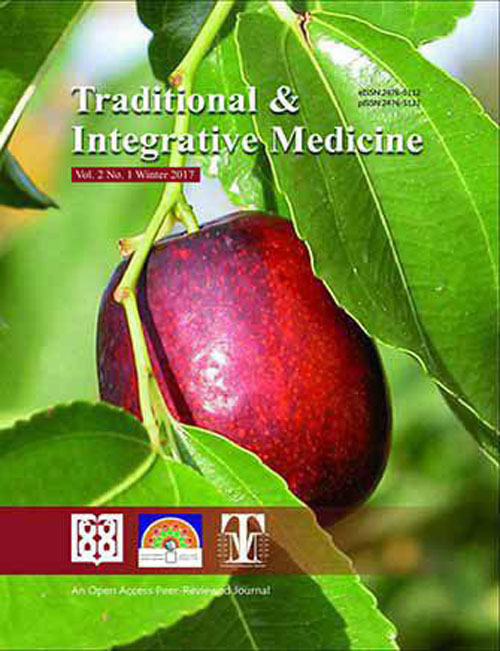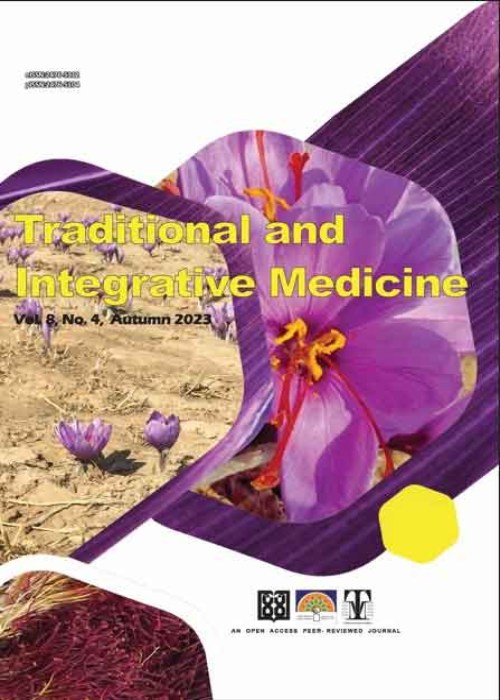فهرست مطالب

Traditional and Integrative Medicine
Volume:2 Issue: 1, Winter 2017
- تاریخ انتشار: 1396/01/26
- تعداد عناوین: 8
-
Pages 3-8Haar-e Gharizi, or the innate natural hot [substance] is the natural fluidic substance that produces the natural heat, Hararat-e-Garizi. These two concepts are sometimes used interchangeably but the fact is that Haar may be considered as the action potential of the body whilst the heat being one of the byproducts of Haars actions. The Haar, is distributed throughout the body by its source, the heart, and ventilated by the heartbeat and breath. Two movements have been described for the Haar: the normal expansion and distribution of Haar to the periphery of the body, and the constriction and condensation of Haar in the core of the body. These currents may both be physiologic or pathologic depending on the duration, strength and extent of each movement. Considering the importance of the balance between these movements, and the dependence of Haar on heat to stay in optimal state, it is proposed that external heat therapy can be used to treat various diseases by strengthening the pump of the Haar (the heart), and opening its pathway (the vessels). Named SINA, this modified sauna therapy is highly individualized, corresponding to the patients temperament, and at the same time monitored and managed based on emergence of warning symptoms. Thus, SINA therapy opens a whole new perspective in treatment of a wide range of diseases by means of the bodys own powerful potential, the Haar.Keywords: Haar, Hararat-e Gharizi, Traditional Persian Medicine (TPM), Avicenna, sauna, SINA therapy
-
Pages 9-14Ancient and medieval medical Iranian manuscripts are of great importance for research and study in two academic fields of Traditional Iranian Medicine and Pharmacy. Nowadays, products based on these manuscripts such as monographs, databases, software packages, and statistical analyses for drug screening are predicted to have entrepreneurial potential. In winter 2016, Phytopharmaceutical Technology and Traditional Medicine Incubator held a one-week startup in order to train twenty undergraduate students how to use ancient medical manuscripts for writing one standard monograph of a medicinal plant. Also, they came up with productive ideas based on using manuscripts, and after that, they worked on writing a business plan and business model of their suggested product.Keywords: Traditional Iranian Medicine, Medical Manuscripts, Entrepreneurship, Startup
-
Pages 15-23The aim of this study was to investigate the effect of boldenone and aerobic training with Jujube extract and Gallic acid on glutathione peroxidase and catalase in heart tissue of male Wistar rats. Thus, 42 male Wistar rats aged 8-12 weeks (weight 195±7.94g) were randomly divided into 7 groups: control, boldenone (5mg/kg), jujube (Ziziphus jujuba) extract boldenone, Gallic acid boldenone, endurance training boldenone, endurance training Ziziphus jujuba extract boldenone, and endurance training Gallic acid boldenone. Endurance training protocol was performed 5 days a week for 8 weeks, each session 60 minutes at 25 to 30 meters per minute. Injection once a week, on an appointed day, and in the hamstring was conducted in depth. After anesthesia, autopsy was performed and the cardiac tissue isolated. Data were analyzed using t-test, one way ANOVA and Scheffe post hoc at the PKeywords: Boldenone, Jujube, Gallic acid, Aerobic training, Heart tissue, glutathione peroxidase, catalase
-
Pages 24-26"Self-referral" as a specific type of conflict of interest, could potentially interfere with the integrity of an "appropriate referral" which should be practiced based on the unique needs of each patient. Referring patients to health facilities where the traditional therapist or physician "has investment interests or is part/full owner of such facilities" is ethically unacceptable and considered to be a kind of self-referring. We, in line with international community and as a professional duty, are obliged to abstain from such a problem. Considering the fast-growing global request for natural products, this ethical and professional issue needs crucial considerations respecting legislation, legal and professional detection and controls. In this way, potentiate the Traditional Pharmacy specialty (Ph.D), practical education of interested pharmacists regarding traditional medications, defining standards for traditional herbal preparations, cessation of preparation of traditional remedies by physicians are among the suggestions could be followed for professional handling of the problem. It is also the right time for compiling ethical codes covering global concerns for ethical prescription of traditional medications.Keywords: Conflict of interest, Natural products, Self-referral, Ethics, Traditional medicine
-
Pages 27-30Endometriosis is a benign disease of women which is often displayed with chronic pelvic pains and sterility. Ovary endometrioma is one of common causes of pelvic pains and among the most common ovary cysts. Treatment of endometriosis is performed with different methods which classified in two major categories: medicinal and surgical treatments. Nowadays it is recognized that medicinal treatment alone is not enough and the necessity for surgical intervention in these patients is confirmed.
A 37-year-old woman referred to Traditional Medicine Clinic of Tehran at Imam Khomeini Hospital about six months after endometriotic ovary cyst surgery with complaint of recurrent pain and heaviness in the pelvic area. According to symptoms and ultrasound report, squill oxymel, Vitex agnus-castus in the form of capsule, Habe cyst (a pill containing celery seed and rosa damascena) and astringent hydrotherapy (a sitz bath containing oak apple, myrtle and pomegranate) were prescribed. The patient was advised to continue the above treatment for two months. In third referral (two months after the second referral), feeling of pain and heaviness in pelvic area was completely disappeared and in performed ultrasound (Figure 2), ovary was reported without any cysts.
Based on high effects of pharmacotherapy and surgery for patient, it seems that using effective herbal products declines effects arising from above treatments with less expenditure. By confirmation, these treatments are effective solutions, at lower cost and with much less side effects in treatment of endometriosis.Keywords: Traditional Persian Medicine, Endometriosis, Ovary cyst, Chronic pelvic pain, Infertility -
Pages 31-38Leukemia is the most common malignant neoplasm during the childhood and constitutes about 31% of malignancies in under-15-year-old children.
We report a 3-year-old boy with acute lymphoblastic leukemia and a history of cancer complications and 9 months treatment process. After 2 months of unsuccessful treatment in a hospital in Bojnurd city, the patient was referred to Dr. Sheikh Hospital of Mashhad to undergo chemotherapy and different and frequent diagnostic methods. Due to lack of response to treatment, repeated relapses and lack of adequate financial resources and inability to pay the costs of repeated chemotherapy and radiotherapies he patient returned to Bojnurd after 9 months. With complaint of severe side effects and complications of drug treatments, the patient referred to Bojnurd traditional medicine center for treatment in September 2008. During the examination, the patient appeared pale with weak pulse, cold and swollen body. The patient was very weak and barely able to speak. After entering the traditional medicine clinic, the patient was controlled for his health and nutrition. In this case, the pharmaceutical measures were according to his temperament and disease status including the medicinal herbs and combined drugs. Manual actions were used for patient including full cupping therapy of back every night until the end of the therapy, Hijama (bloodletting) and massage therapy. The recovery appeared in the whole body from the fourth week. Since the patient's physical force and general status became much better, the routine tests were recommended of which hemoglobin and hematocrit test results were significantly better. After 8 months, all of the tests were normal and there was no relapse in clinical and laboratory tests until 2016.
Given the patient's recovery process with an approach to his physical power, mental status, cancer control, and significant recovery of acute lymphoblastic leukemia and complications caused by cancer and chemotherapy, it seems that the combination of modern and traditional medicine can pave the way for most of the common diseases, and thus it is essential to conduct widespread assessments of different diseases based on teachings of Iranian Effective Medicine.Keywords: Acute Lymphoblastic Leukemia, Traditional Medicine, Modern Medicine, Leech Therapy -
Pages 39-52Dalk is one of the oldest forms of therapies in use since ancient times. It involves the manipulation of body tissues with hands, cloth or any suitable object. In Unani medicine, dalk is based on the principle of tanqiyah (expulsion) and imāla (diversion). In addition to the comforting feeling provided by human touch, massage has been demonstrated to have clinically significant physiological effects on the body. It increases blood flow, reduces stress and also has immediate sedative effects. Depending on the individual patient, different types of dalk are described which are used in combination with certain medicines or oils, or with bare hands for different disorders. Although largely a safe therapy, a few contraindications do exist, which are mainly advised for prevention of any adverse events. Unani physicians made significant advances into dalk and devised specific prescriptions for a large number of ailments. The prescribed formulations for dalk are mostly oils, but in certain conditions the decoction, paste, powder or extract of drugs is also prescribed, the basis of which is the individual mizāj (temperament) and also the disease.Keywords: Dalk, Massage Therapy, Morbid Matter


